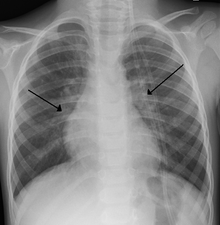User:Mr. Ibrahem/Bronchiolitis
| Bronchiolitis | |
|---|---|
 | |
| An X-ray of a child with RSV showing the typical bilateral perihilar fullness of bronchiolitis. | |
| Specialty | Emergency medicine, pediatrics |
| Symptoms | Fever, cough, runny nose, wheezing, breathing problems[1] |
| Complications | Respiratory distress, dehydration[1] |
| Usual onset | Less than 2 years old[2] |
| Causes | Viral infection (respiratory syncytial virus, human rhinovirus)[2] |
| Diagnostic method | Based on symptoms[1] |
| Differential diagnosis | Asthma, pneumonia, heart failure, allergic reaction, cystic fibrosis[1] |
| Treatment | Supportive care (oxygen, support with feeding, intravenous fluids)[3] |
| Frequency | ~20% (children less than 2)[1][2] |
| Deaths | 1% (among those hospitalized)[4] |
Bronchiolitis is blockage of the small airways in the lungs due to a viral infection.[1] It usually only occurs in children under the age of two-years.[2] Symptoms may include fever, cough, runny nose, wheezing, and breathing problems.[1] More severe cases may be associated with nasal flaring, grunting, or the skin between the ribs pulling in with breathing.[1] If the child has not been able to feed properly, signs of dehydration may be present.[1]
Bronchiolitis is usually the result of infection by respiratory syncytial virus (70% of cases) or human rhinovirus (26% of cases).[2][5] Diagnosis is generally based on symptoms.[1][5] Tests such as a chest X-ray or viral testing are not routinely needed.[2][5]
There is no specific treatment.[3][6] Supportive care at home is generally sufficient.[5] Occasionally hospital admission for oxygen, support with feeding, or intravenous fluids is required.[1] Tentative evidence supports nebulized hypertonic saline.[7] Evidence for antibiotics, antivirals, bronchodilators, or nebulized epinephrine is either unclear or not supportive.[8]
About 10% to 30% of children under the age of two years are affected by bronchiolitis at some point in time.[1][2] It more commonly occurs in the winter in the Northern hemisphere.[1] It is the leading cause of hospitalizations in those less than one year of age in the United States.[6] The risk of death among those who are admitted to hospital is about 1%.[4] Outbreaks of the condition were first described in the 1940s.[9][10]
References
[edit]- ^ a b c d e f g h i j k l m Friedman JN, Rieder MJ, Walton JM, Canadian Paediatric Society, Acute Care Committee, Drug Therapy and Hazardous Substances (November 2014). "Bronchiolitis: Recommendations for diagnosis, monitoring and management of children one to 24 months of age". Paediatrics & Child Health. 19 (9): 485–98. doi:10.1093/pch/19.9.485. PMC 4235450. PMID 25414585.
- ^ a b c d e f g Schroeder, AR; Mansbach, JM (June 2014). "Recent evidence on the management of bronchiolitis". Current Opinion in Pediatrics. 26 (3): 328–33. doi:10.1097/MOP.0000000000000090. PMC 4552182. PMID 24739493.
- ^ a b Hancock, DG; Charles-Britton, B; Dixon, DL; Forsyth, KD (September 2017). "The heterogeneity of viral bronchiolitis: A lack of universal consensus definitions". Pediatric Pulmonology. 52 (9): 1234–1240. doi:10.1002/ppul.23750. PMID 28672069.
- ^ a b Kendig, Edwin L.; Wilmott, Robert W.; Boat, Thomas F.; Bush, Andrew; Chernick, Victor (2012). Kendig and Chernick's Disorders of the Respiratory Tract in Children. Elsevier Health Sciences. p. 450. ISBN 978-1437719840. Archived from the original on 27 July 2020. Retrieved 5 June 2020.
- ^ a b c d Dalziel, SR; Haskell, L; O'Brien, S; Borland, ML; Plint, AC; Babl, FE; Oakley, E (30 July 2022). "Bronchiolitis". Lancet (London, England). 400 (10349): 392–406. doi:10.1016/S0140-6736(22)01016-9. PMID 35785792.
- ^ a b Kirolos, Amir; Manti, Sara; Blacow, Rachel; Tse, Gabriel; Wilson, Thomas; Lister, Martin; Cunningham, Steve; Campbell, Alasdair; Nair, Harish; Reeves, Rachel M.; Fernandes, Ricardo M. (2019). "A Systematic Review of Clinical Practice Guidelines for the Diagnosis and Management of Bronchiolitis". The Journal of Infectious Diseases. doi:10.1093/infdis/jiz240. PMID 31541233. Archived from the original on 4 September 2020. Retrieved 23 October 2019.
- ^ Zhang, L; Mendoza-Sassi, RA; Wainwright, C; Klassen, TP (21 December 2017). "Nebulised hypertonic saline solution for acute bronchiolitis in infants". The Cochrane Database of Systematic Reviews. 12: CD006458. doi:10.1002/14651858.CD006458.pub4. PMC 6485976. PMID 29265171.
- ^ Brooks, CG; Harrison, WN; Ralston, SL (18 April 2016). "Association Between Hypertonic Saline and Hospital Length of Stay in Acute Viral Bronchiolitis: A Reanalysis of 2 Meta-analyses". JAMA Pediatrics. 170 (6): 577–84. doi:10.1001/jamapediatrics.2016.0079. PMID 27088767.
- ^ Anderson, Larry J.; Graham, Barney S. (2013). Challenges and Opportunities for Respiratory Syncytial Virus Vaccines. Vol. 372. Springer Science & Business Media. p. 392. doi:10.1007/978-3-642-38919-1_20. ISBN 9783642389191. PMC 7121045. PMID 24362701. Archived from the original on 6 December 2017. Retrieved 4 December 2017.
{{cite book}}:|journal=ignored (help) - ^ Ralston, Shawn L.; Lieberthal, Allan S.; Meissner, H. Cody; Alverson, Brian K.; Baley, Jill E.; Gadomski, Anne M.; Johnson, David W.; Light, Michael J.; Maraqa, Nizar F.; Mendonca, Eneida A.; Phelan, Kieran J. (2014-11-01). "Clinical Practice Guideline: The Diagnosis, Management, and Prevention of Bronchiolitis". Pediatrics. 134 (5): e1474–e1502. doi:10.1542/peds.2014-2742. ISSN 0031-4005. PMID 25349312. Archived from the original on 23 October 2019. Retrieved 23 October 2019.
